
Handling an employee’s contract breach effectively is essential to avoid costly legal disputes and potential damage to your business. Employment contracts are vital in protecting your interests, outlining both party’s obligations, and providing a framework for addressing any breaches.
This article aims to equip employers with a comprehensive understanding of the implications of employee breaches and proactive measures to prevent such occurrences. In fact, in a recent survey by Legal Templates, almost 60% of employees admitted to having breached their employment contracts. Armed with insights, we’ll delve into the necessity of well-drafted employment contracts in order to safeguard employers’ interests.
What Is an Employment Contract Breach?
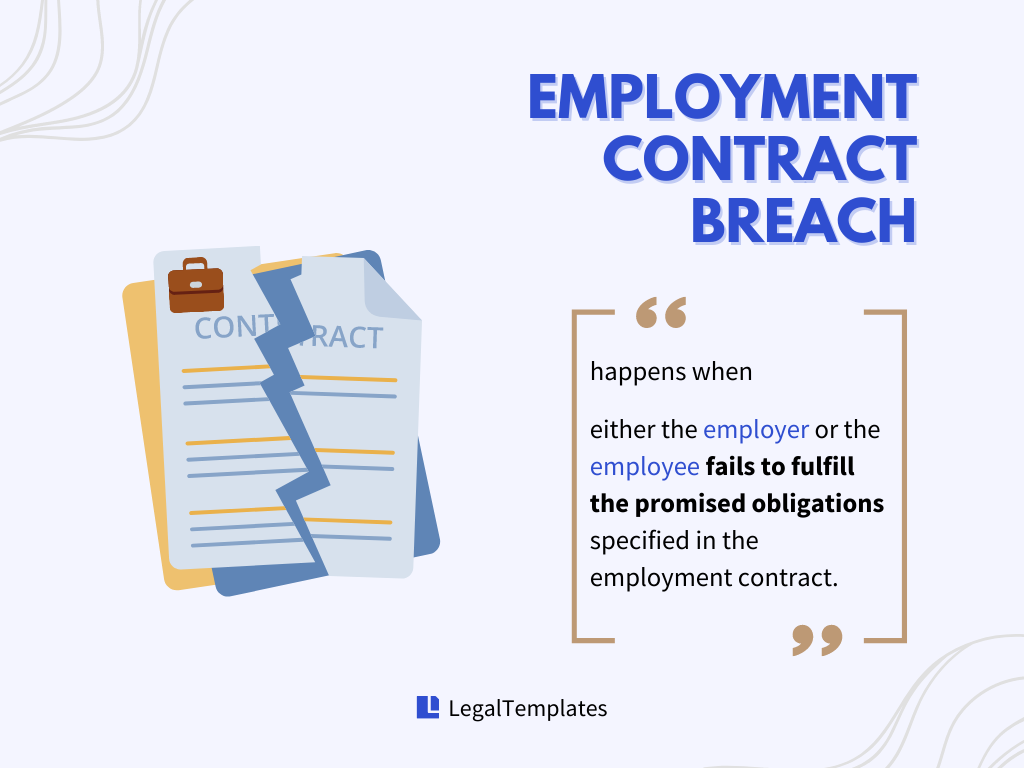
A breach of an employment contract occurs when either the employer or employee fails to meet the agreed-upon terms.
Note that an employment agreement can carry both explicit terms — those that are clearly written on the contract — and implied terms, such as those enforced by statute (e.g., equal pay, minimum wage), common law (e.g., duty of trust and confidence), or employer or industry custom. Breaching an implied term can bring consequences as severe as breaching an express term.
Employment Contract Breach Statistics
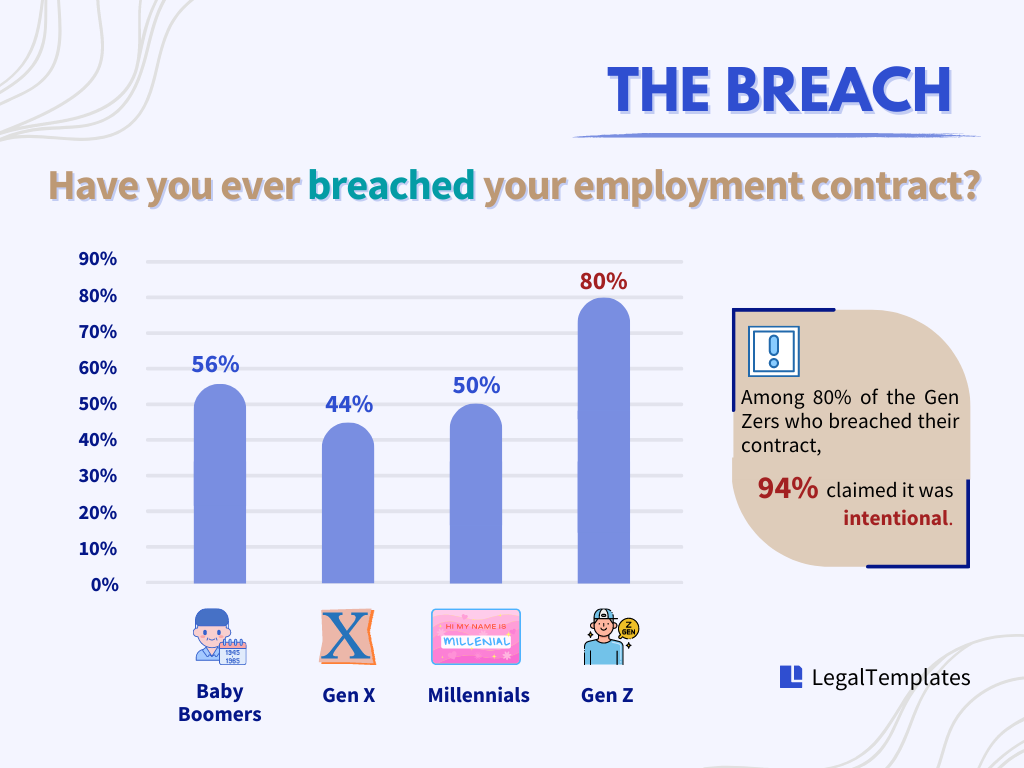
In our recent survey with 1,002 employees as participants, a significant 57% admitted to breaching their employment contracts at least once. The data was even more startling among Gen Z participants, with an alarming 80% acknowledging such breaches, and 94% of them indicating that they did so deliberately.
This highlights the prevalence of contract breaches and the importance of understanding their negative implications and how to deal with them.
Can an Employee Breaches the Contract After the Employment Ends?
Yes. After an employee’s departure, post-employment obligations in the employment contract, such as trade secret confidentiality, client and employee solicitation restrictions, and property return, can still be breached.
Common Examples
In the case of an employee breaching an employment contract, common examples can include:
- Unauthorized absence: For example, imagine an employee consistently fails to show up for work without notifying their supervisor or providing a valid reason. To prevent such occurrences, integrating an efficient online scheduling tool can help streamline meeting arrangements, ensure timely reminders, and reduce the chances of missed appointments or delays. This kind of behavior not only disrupts the workflow but also damages client relationships and the company’s reputation.
- Confidentiality breach: For example, an employee working in a Telehealth software development firm leaks proprietary software code or client data to a third party without authorization. If a software developer shares sensitive project details with a competitor, this breach could result in significant financial loss and legal repercussions for the company. Such actions violate the confidentiality clause in their contract and can lead to immediate termination or legal action.
- Negligence in duties: For example, picture a warehouse manager who consistently neglects inventory checks, leading to stock shortages and operational delays. This negligence can result in financial losses and disrupt the supply chain. By failing to perform their job duties as expected, the manager breaches their contract and may face disciplinary action or termination.
- Misconduct or unprofessional behavior: For example, imagine an employee engaging in discriminatory behavior or harassment towards colleagues, creating a toxic work environment. A team leader who makes derogatory remarks about a coworker’s race or gender not only violates company policies but also breaches their contract. This could lead to their dismissal and possible legal consequences.
Impact of Employment Contract Breaches
The consequences of an employment contract breach by an employee vary by degree but are often irreparable, even with legal recourse. Below are some commonly seen consequences that can result from a breach.
Financial Losses
When an employee neglects their duties or abandons their post without proper notice, it can severely hamper productivity. You might have to bear the cost of overtime pay for other employees to cover the work or the expense of hiring temporary workers. In addition, you must allocate resources to hire and train a replacement, which is both time-consuming and costly.
Damage to Reputation
An employment contract breach, particularly if it involves high-profile employees, scandalous behavior, or becomes public knowledge, can seriously damage a company’s reputation. It can erode trust and goodwill among clients, customers, and even among the remaining employees. The recovery process from such a hit can be long, challenging, and may require a significant investment in public relations and damage control initiatives.
Legal Costs
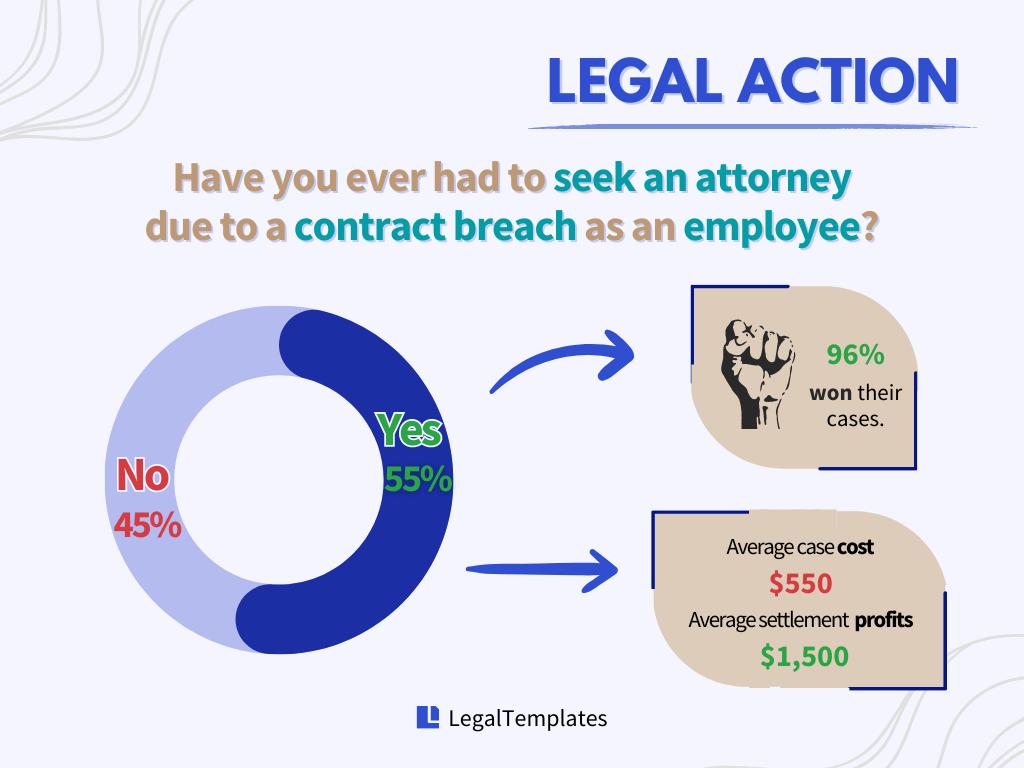
Legal action may be necessary if an employee breaches their employment contract, particularly in cases involving theft of proprietary information or violation of confidentiality clauses. The costs associated with legal proceedings can be substantial; additionally, the time and effort spent on a lawsuit can divert resources away from business operations, contributing to indirect financial losses.
Our employment survey results show the monetary costs legal proceedings can cause for businesses. For employees who sought lawsuits due to an employment contract breach, 95% won their cases, and their settlement profits averaged $1,500.
Taking Action When a Breach Occurs
How you respond to an employee’s breach of contract could vary greatly depending on the breach that occurred. Business attorney Brooke Davis provides below a brief guideline for commonly seen employment contract breaches by employees.
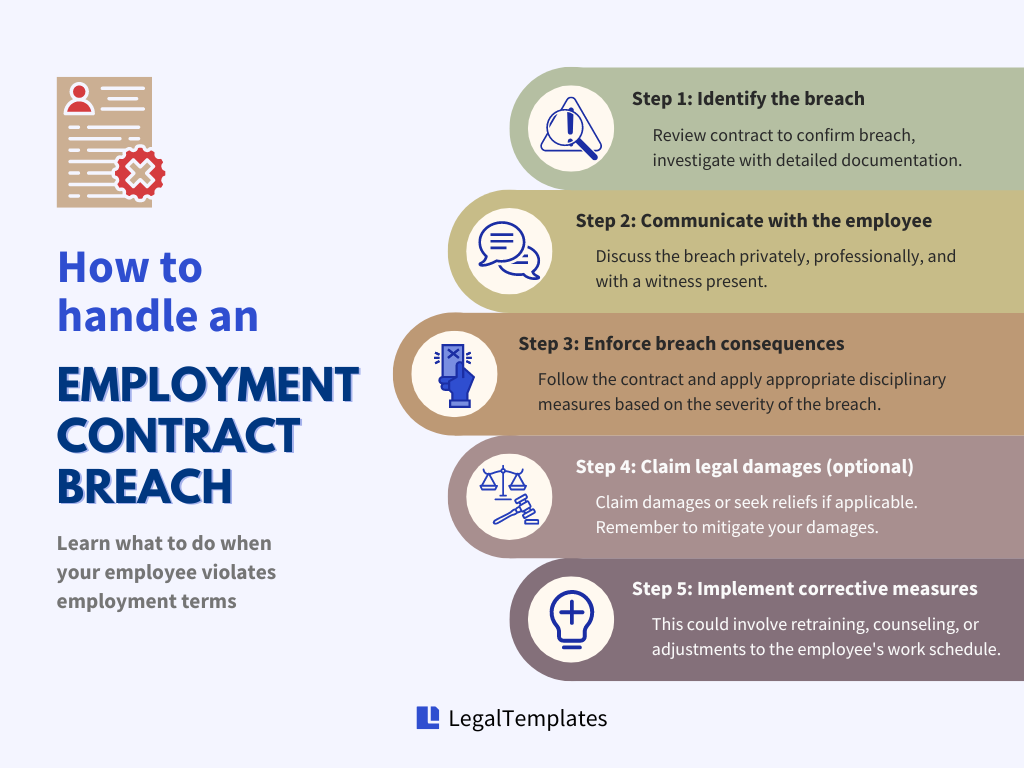
Step 1: Identify and Document the Breach
Identify the breach by reviewing the terms of the employment contract to ensure that a breach has occurred. Next, investigate the breach and document it in detail. Include dates, times, and specific incidents, as these will be crucial if the situation escalates.
What if I Don’t Have a Contract?
If there is no actual paperwork of the employment, find proof that the employment relationship was established, such as records of salary payments or work equipment you prepared for the employee.
Step 2: Communicate with the Employee
Discuss with the employee about the breach. It’s important to debate the issue in a private, professional manner with a third-party witness present. The employee should be given a chance to explain the breach.
If the employee breaches confidentiality, you may be required to disclose the breach to third parties, such as clients or associates. Apart from the involved parties, you should maintain confidentiality of sensitive information throughout the communication process.
Step 3: Enforce Consequences
Follow the contract to determine the appropriate course of action. In the case of a mild breach, disciplinary measures such as a written reminder or warning are common. The warning should detail the breach and outline the consequences of further breaches (which is usually termination).
If the violation is a severe breach such as misconduct or a confidentiality violation, consequences may range from suspensions to termination. You may also need to take legal action to prevent further harm to your business (or if the employee breaches the contract after resignation).
If the contract does not explicitly outline the penalties for the breach, the specific consequences may vary depending on applicable employment laws, jurisdiction, and the circumstances of the violation.
Step 4: Claim Damages (Optional)
In the case of serious misconduct, you may consider initiating legal action to claim damages.
The damages available to employers can vary depending on the jurisdiction and the specific terms of the contract. However, here are some common types of damages that employers may seek in cases of breach of an employment contract:
Types of Damages
| Type of Damage | Description |
|---|---|
| Compensatory Damages | Compensate the employer for any financial losses incurred as a result of the breach. Example: If an employee breaches a non-compete clause and takes a job with a competitor, the employer may seek damages for any lost profits or business opportunities resulting from the breach. |
| Specific Performance | Requires the employee to fulfill their contractual obligations. More commonly sought when the services of the breaching party are unique or when monetary damages would not adequately compensate the employer. Example: If an employee with unique skills leaves a vital project unfinished in breach of the employment contract, the employer may pursue specific performance and compel the employee’s return and completion of the project as specified in the contract. |
| Injunctive Relief | Prevents the breaching party from engaging in certain activities. Example: If an employee breaches a confidentiality agreement by disclosing sensitive information, the employer may seek an injunction to prevent further disclosure or use of the information. |
| Liquidated Damages | Specifies a predetermined amount of damages to be paid in the event of a breach. Enforceable if the specified amount is a reasonable estimate of the actual damages likely to be incurred and not seen as a penalty (reasonability determined by the court). |
| Restitution | Recovers any benefits or payments made to the breaching party. Common when an employee has received compensation or other benefits that were not rightfully earned due to the breach. Example: If an employee fails to return company property (as required in the employment contract) upon resignation, the employer may seek restitution to recover the property’s value that was not returned. |
Remember, employers have a duty to mitigate their damages. This means taking reasonable steps to minimize the losses resulting from the breach.
Is Litigation the Only Way?
Depending on the nature of the breach and the willingness of both parties to resolve the issue, alternative dispute resolution methods, such as mediation or arbitration, may be considered. These approaches can lead to a mutually agreed-upon resolution without litigation.
Step 5: Implement Corrective Measures
Work with the employee to implement corrective measures. This could involve retraining, counseling, or adjusting the employee’s work schedule or responsibilities.
Regardless of the severity of the breach, it’s crucial to handle the situation professionally and legally to protect your business and maintain a fair workplace. Remember, each case is unique, and these are general guidelines.
Prevention Strategies: Tips from a Business Attorney
As you can tell by now, preventing a contract breach is far more cost-effective than dealing with one. Below some strategies for you to consider from are business attorney Brooke Davis.
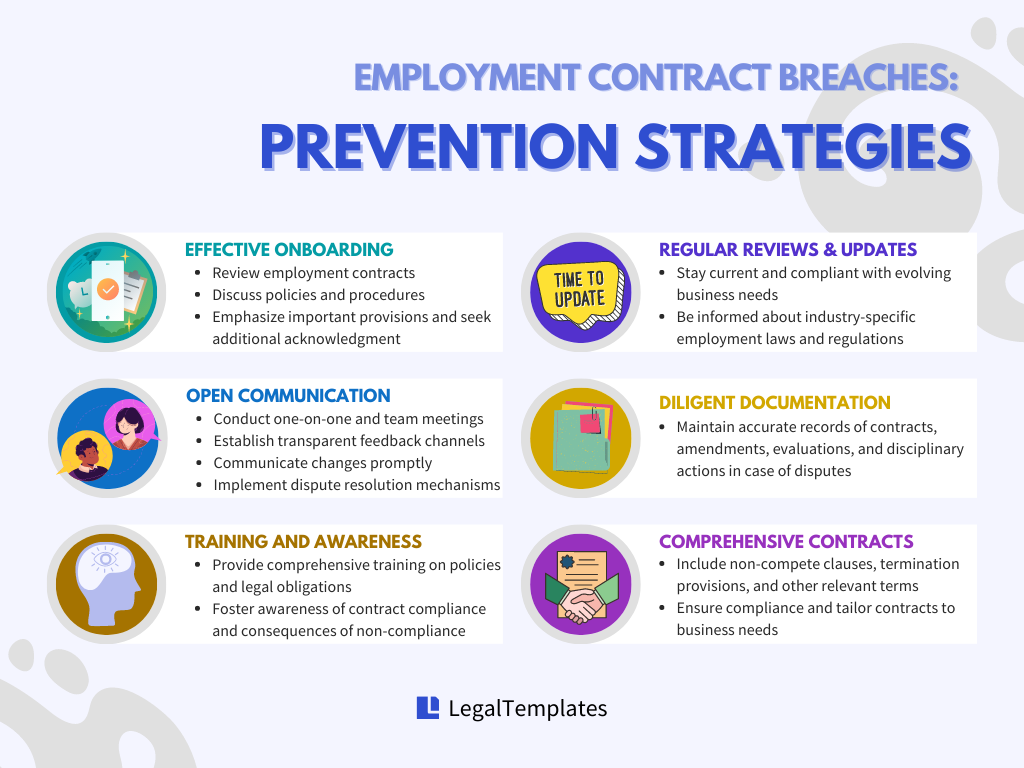
Effective Onboarding
Ensure new employees receive a comprehensive orientation that includes:
- Reviewing the employment contract;
- Discussing key policies and procedures;
- Addressing questions;
- Setting clear expectations.
Our employee survey shows less than 1 in 5 employees read their employment contracts thoroughly before signing them. To prevent unintentional breaches resulting from a lack of awareness, you may emphasize important contract provisions by asking for additional acknowledgment from the employee.
Brooke's Tip
Consider implementing quizzes or assessments to reinforce understanding of critical internal documents.
Regular and Open Communication
Maintain open lines of communication with employees. Regularly communicate with them about their performance, expectations, and any changes that may affect their employment. Provide constructive feedback, address concerns promptly, and encourage dialogue to ensure a clear understanding of the contract terms.
Some common measures you can implement include:
- Regular one-on-one meetings;
- Scheduled team meetings;
- Transparent feedback channels (i.e., suggestion boxes, anonymous surveys);
- Employee newsletters.
You should also establish effective internal dispute resolution mechanisms — such as grievance procedures or mediation processes — to address any concerns or conflicts.
Training and Awareness Sessions
Considering that 57% of employees have breached their contracts at least once, there is a pressing need for effective training and awareness sessions. The sessions can cover various topics, from company policies and procedures to legal obligations relevant to the employees’ roles.
By ensuring employees are well-informed, they are more likely to adhere to the terms of their employment contracts and understand the severe implications of non-compliance.
Regular Reviews and Updates
Stay current and compliant with evolving business needs and legal requirements. During regular updates, you may incorporate changes related to compensation, benefits, intellectual property, non-disclosure agreements/clauses, and any applicable regulations.
In addition, stay informed about employment laws and regulations applicable to your industry and location. You can hire an internal or external counsel or (at minimum) invest in legal research software with research tools and real-time updates for case law and other legislative updates, such as Westlaw and LexisNexis.
You may include a provision in all employment contracts stating that you, as the employer, reserve the right to update the policies and procedures at any time.
When you update a signed employment contract, it is good practice to notify the employee of the changes. However, substantial changes to the terms of the employment (e.g., work location, work hours, salaries) must be mutually agreed upon by both parties.
Diligent Documentation
Maintain accurate and comprehensive records of employment-related matters, including signed contracts, amendments, performance evaluations, disciplinary actions, and other relevant documentation. Good record-keeping helps establish clarity, track employee performance, and provide evidence in the event of a dispute.
Comprehensive Contracts
A clear, comprehensive, well-drafted contract is your best defense against a breach, as it outlines the consequences of such violations and offers protection for yourself in case disputes arise or legal action becomes necessary.
Clearly define the terms and conditions of employment, including confidentiality obligations, termination provisions, and any other relevant terms. Seek legal guidance to ensure contracts comply with applicable laws and are tailored to your specific business needs.
Key aspects such as wages, benefits, and job responsibilities should also be transparently outlined, as these were identified as top concerns among two-thirds of employees who participated in our survey.
Conclusion
Understanding and adhering to employment contracts is crucial in today’s business environment. Not only can a breach lead to significant financial loss, but it can also damage your company’s reputation.
Employment contracts and related documents are vital to any business. These agreements form the foundation of the employer-employee relationship and serve as a framework for potential breach of contract actions:
- Employment Offer Letter
- Confidentiality Agreement
- Arbitration Agreement
- Handbook Acknowledgment
- Commission Agreement
- Non-Compete Agreement
Remember, the best offense is a good defense. Safeguarding your business requires comprehensive, well-communicated contracts. Protect your company by joining the 100,000 users who have created their employment agreements with us today.
